#so much commentary on personal codes of justice and saving people. but they throw it out when it comes to saving someone they don’t agree w
Text
oh my g od i was right i was not prepared for the finale
#tiger and bunny#tiger and bunny spoilers#glad yuri got to not look like a total disaster for once#like i’m upset that he ended like that but. he looked cool. i hope he comes back and pretends nothing happened#idk i’m kinda unsatisfied with it tbh#like all that build up of it being connected to ouroboros and then nothing#and the whole i’m gonna kill aurora to save the next thing? ehhhhh#idk. it was a twist sure. but i feel like it didn’t totally fit with the whole mission a lead up. it was very clearly the prison#and they switched it for shock value. i think making the mission audon would’ve made more sense but idk#idk man. i’m gonna go read fix it’s because petrov is the best character in the show#also just. everything about people interacting with yuri felt. off this season#kotetsu saying he still supported legend?? barnaby and him putting absolute minimum effort into saving yuri from himself? they would never#i’m just saying. one of them would’ve jumped after him. or at least fucking looked for him#so much commentary on personal codes of justice and saving people. but they throw it out when it comes to saving someone they don’t agree w/
7 notes
·
View notes
Photo

Books read in July
With one or two exceptions, these were books were sources of FEELINGS.
Favourite cover: The Enigma Game, nut most of these covers are a good fit for the stories they represent.
Reread: “The Marriage of Mary Russell” by Laurie R. King, “Something Worth Doing” by Elizabeth and I also listened to quite a bit of Code Name Verity (by the same).
Also read: “Monster” by Naomi Kritzer.
Still reading: A Wizard’s Guide to Defensive Baking by T. Kingfisher.
Next up: Stars Above by Marissa Meyer.
(Longer reviews on LibraryThing and Dreamwidth.)
*
Descendant of the Crane by Joan He (narrated by Nancy Wu): Princess Hesina of Yan, believing her father to be murdered, opens an investigation into his death. She’s driven by her aching grief and by her fierce desire for truth and justice -- for all her people, as well as in this matter of her father’s death. But the truth is much harder than she expects. I thought this was incredible, but sometimes stressful! Compelling characters, complex family dynamics (I especially liked the sibling relationships), intricate prose and worldbuilding, and startling twists that turned out to slot neatly in with the other puzzle pieces.
Riviera Gold by Laurie R. King: This takes place in July 1925, immediately after Island of the Mad. Mary Russell leaves Venice for Monaco, hoping to see her former housekeeper -- and discovers that Mrs Hudson has been accused of murder. As always, I love Russell's first person narration and her observations of the world around her. The historical scenery is particularly vivid: cliffs and ocean views, the Monte Carlo casino, expats with questionable pasts and connections, smugglers, Jazz Age artists, bronze casting. Moreover, it’s all relevant to the mystery Russell is unravelling. I also liked the indications that Russell and Holmes’ unconventional marriage works for them.
Fireweed by Jill Paton Walsh: A short bittersweet novel from 1969 about two runaway evacuees living on the streets of London during the Blitz. It’s very vivid, particularly the details about wartime London -- but there’s also a thread of ambiguity, because the narrator is looking back on a time he doesn’t fully remember and didn’t always understand. In the end, that becomes a bit unsatisfying, yet I like how the story allows one to fill in some of the gaps for oneself. I wish I had discovered this at thirteen -- I’d have appreciated it even more and been fascinated by the experience of fending for oneself.
Aurora Burning by Amie Kaufman and Jay Kristoff: After everything that happened in Aurora Rising, Squad 312 have been labelled traitors but they are not going to let that stop them from saving the world. This is fast-paced, with some excellent twists and frustrating developments. Sometimes the action was engaging; other times my eyes glazed over. Sometimes the multiple POV was a strength; other times I felt it hindered me from becoming really attached to anyone. Sometimes I was amused by the characters, and other times the qualities which make them amusing became irritating. I think the things I liked outweighed the things I didn’t care for?
The A.I. Who Loved Me by Alyssa Cole: Trinity is working from home after a traumatic accident when she meets her neighbour’s strange nephew, Li Wei. This science-fiction romance has mystery, humour and moments of very pointed commentary. I enjoyed Li Wei working out how to act like a human again, and the interactions with Penny, the Home AI assistant. There is more going on here than either Trinity or Li Wei initially realises, which is great --- but that reveal indicates that some important, interesting parts of this story have been glossed over. I might have liked this more if the flashbacks had been expanded.
“Monster” by Naomi Kritzer (from Clarkesworld Magazine, issue 160): This alternates between Cecily’s time in China, looking for an old school friend, and the history of that particular friendship. I don’t regret reading (well, listening to) this, but I don’t know if I liked it. It is tense and uneasy, and left me wishing I had someone with whom I could discuss interpretations of the ending’s implications.
Gravity is the Thing by Jaclyn Moriarty (narrated by Aimee Horne): This grew on me. In the end, I loved it. For twenty years, Abigail’s been sent chapters of a mysterious self-help book. The story alternates between the present, as Abigail learns more about The Guidebook, and her reflections about her past -- particularly her brother, her marriage, being a single mother. At times this story is uncomfortable but the way everything is drawn together -- and seeing Abigail make sense of her life -- was unexpectedly satisfying. Compelling. I also liked the Australian setting, the Aussie audiobook narrator, some of the whimsical parts and how Maybe The Real Treasure Was the Friends We Made Along the Way.
The Enigma Game by Elizabeth Wein: Like The Pearl Thief, this is a prequel/companion novel to Code Name Verity. In late 1940, nineteen year old Jamie is an RAF pilot in northern Scotland. His friend Ellen, a driver for the aerodrome, is staying at the same pub as Louisa (newly-orphaned, half-Jamaican), who is caring for an elderly German woman. Together they discover a way to keep Jamie’s squadron ahead of the Germans. I loved this. A powerful exploration of identity, secrets and the problems of prejudice. I was delighted (and also devastated) by how this story fits in with Code Name Verity. The bits about flying are lovely.
Hamster Princess: Giant Trouble by Ursula Vernon (aka T. Kingfisher): After Ratpunzel, Harriet’s next adventure involves magic beans, a giant bunny and a hamster who wants to form a band.
There is something very soothing about making tea. You have to concentrate on the whole process, and then you have tea. Even someone as decisive as Harriet had to make tea sometimes and think things through.
Kind of Cursed by Stephanie Fournet: Millie has been dealing with a lot -- losing her parents, gaining guardianship of her younger siblings, a miscarriage and a relationship break-up. She’s decided to avoid men for the next decade. But it’s hard to avoid Luc, who is overseeing the renovation of Millie’s kitchen. Watching Millie find the support, comfort and happiness she so desperately needs gave me warm fuzzy feelings. This has the right I-need-a-hug-vibe, the right ratio of emotional hurt/comfort, for me. In another story, I might have had issues with how quickly the romance becomes a serious relationship, but the characters’ choices made sense in context.
Fall Semester by Stephanie Fournet: This romance between a depressed literature professor and a graduate student with a terminally-ill father was an interesting experience because I was aware of its weaknesses and yet it was such a compelling dose of FEELINGS that I really enjoyed reading it. I also have something of a soft spot for stories about universities -- and perhaps was feeling tolerant, knowing it was the author’s first novel. (Weaknesses included: the prose style is serviceable but bland, an odd fit for protagonists with backgrounds in literature/poetry; their serious issues deserved more focus; and some of Malcolm’s reactions have uncomfortable overtones of entitlement.)
You First by Stephanie Fournet: More compelling feelings, which kept me reading, but in hindsight, didn’t completely sell me on the age-gap or the short time-frame. If only it hadn’t largely skipped over showing the characters navigating an interesting challenge introduced in the final act in favour of an epilogue which picks up some time later! Seriously, if you’re going to throw in that particular complication, then I at least want to watch them deal with it. I’m not grumbling too much. I cared enough about seeing the characters’ situations improve, which counts for something. And what did I expect, reading three romance novels in a row?
Like No Other by Una LaMarche: Two teenagers meet in a New York hospital elevator during a blackout. Devorah is a Hasidic Jew, Jaxon is black. Devorah is not allowed to socialise with boys outside of her family, let alone anyone outside her community, but she and Jaxon keep finding ways to see each other. This was fascinating, but also frustrating -- I was frustrated with Devorah’s culture for making her feel like she would be disowned if she put a foot wrong, and also frustrated, perhaps unfairly, with Jaxon for not fully appreciating the risks Devorah faces. However I liked the ending a lot.
#Herenya reviews books#Joan He#Laurie R. King#Jill Paton Walsh#Amie Kaufman#Jaclyn Moriarty#Elizabeth Wein#Ursula Vernon#Stephanie Fournet#Una LaMarche
1 note
·
View note
Text
Young Justice Theory: So I want to talk about Halo...

I’ve seen a lot of discussion about Halo the character in Young Justice. And, while I’m loathed to throw myself into this discourse, I feel like a lot of misinformation is being bandied about in regard to the character.
Now let me say this much, I am not coming at this from the standpoint of the character being a Muslim girl. Rather I’m coming at this from the standpoint of what and who the character is and why I think a lot of this commentary is…a bit of an issue when it comes to Halo and her role in the series.
So let’s start at the beginning. Who is Halo...?

The original Halo is a girl by the name of Violet Harper who was a troubled teen. She and her then boyfriend stole a drug formula from Tobais Whale (if you watch Black Lighting you will know about this kingpin) and ran off to Markovia where she was killed by an Assassin sent out by Whale. Her body was later found by the the Aurakle, who took it over and revived her. Batman discovered her, and she had no idea who she was. Due to her using Light powers he gave her the code name Halo, so he could at least call her something, and the two helped form the Outsiders to deal with the war in Markovia.
During her time with the Outsiders, Halo takes the name Gabrielle Doe and lives in a penthouse with Katana, becoming Katana’s Legal ward. She attended high school and started to date, making Brion a bit jealous, and the two realized when they spoiled one another’s dates that they loved one another. Eventually Batman found out Halo’s past and she eventually went to live with Violet’s parents, discovered that Violet needed to make amends for her past behavior and then broke things off with Brion.
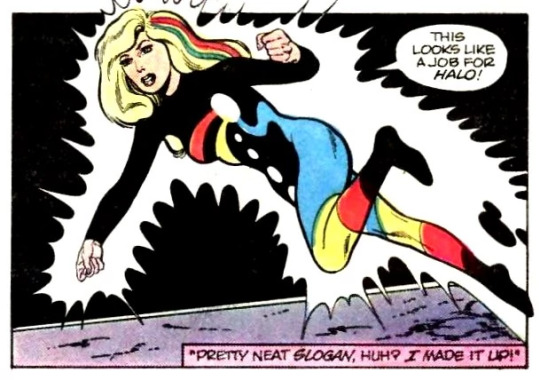
Tobais Whale came back into Halo’s life seeking out the drug formula, and kidnapped her parents. She had no idea what he was talking about as the memory of the theft was gone, even with the help of her friends Violet’s parents were killed. Her memories were returned when the JL discovered what possessed her body, and the Auakle wanted to split her and their friend, killing her in the process. The outsiders saved her, and was finally left in peace to go find herself.
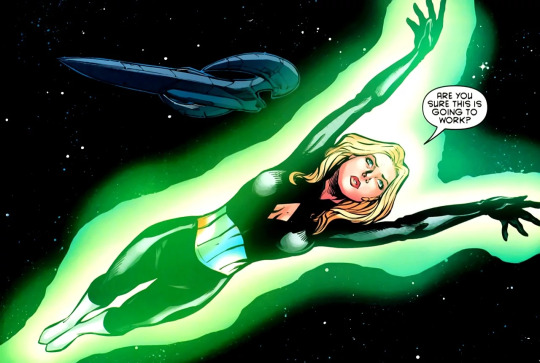
During this time she got lured into the Kobra cult and had to be saved by the Outsiders once more, rejoined them. However her body was killed during events of an attack on Markovia, where the ex wife of one of the Outsiders allies, and Halo took over the body of Marissa Barron, but went by the name of Violet due to connections to her former body.
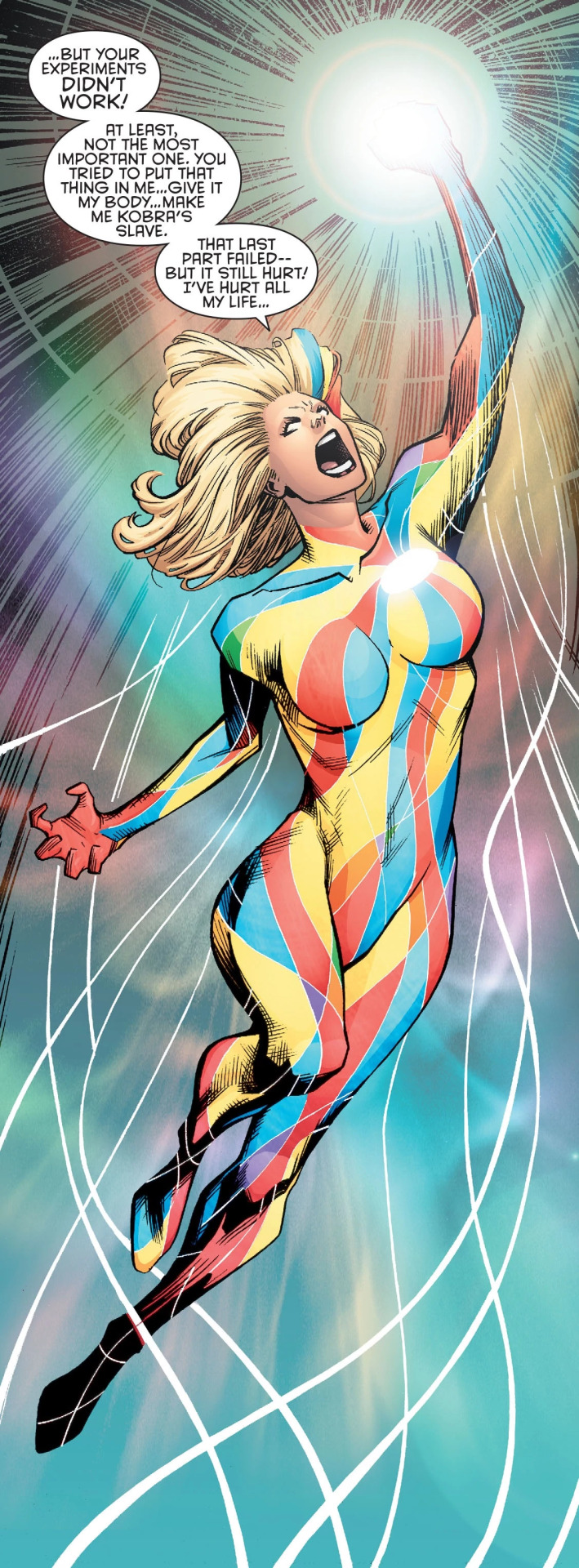
In addition the new 52 redid her story to have it where Violet was imprisoned by the Kobra cult in Markovia. During this time Katana, who is on her own mission, frees Violet and steals a police van with the girl, only for the two to be caught when they stop the van to rest, thinking they’re safe.
In the redone story of Halo, the Aurkles have been captured by Kobra, and with the help of a kidnapped Scientist (I think it’s Dr. Jace) Violet is forced to experimented upon and this gives her super powers. The try to mind control her, but the Aurkles breaks free and kills everyone present but shields Violet from harm. Katana threatens to kill them and they back off allowing her and Violet to escape.
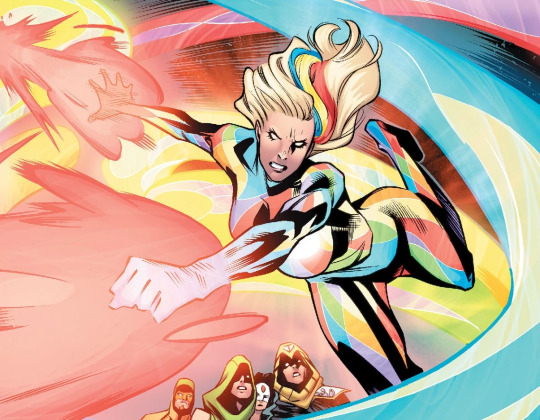
When awake from her ordeal Violet uses her powers but Katana and her partner the Entchantress knock her out. Enchantress at the time tries to free Violet from the Aurkles, but the bond is permanent. During this time the Aurkles try to free their friend, but their actions would have killed Halo, so Enchantress has to kill them to keep her alive. Halo saves Katana and Enchantress and Katana takes Halo on as a sister and offers to let her live with her.
Second question…what is Qurac?
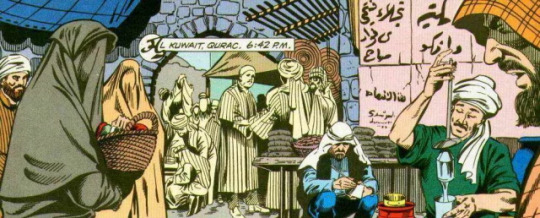
Okay so while one can see Qurac as a fake name for Iraq the two nations are not the same and are independent of one another’s history.
Qurac is a gulf nation that runs along the eastern boarder of the Sinai Peninsula from Oman and Rub’al Khali on the south, Saudi Arabia and the Summan on the west and Iraq and Wadi al Batin on the north.
It’s considered an Outlaw nation due to it’s anti-u.s. policies and was a major sponsor of terrorism in the west. Originally, it was ruled by the Ottoman Empire until around the time of WW1 when English and Arab forces defeated the Empire, and the area then held by England until WW2. Now things get interesting…
So during WW2 the Premier of Iraq, one Al-Gailiani, who was a Arab Nationalist, decided to replace the then moderate Iraqi government with a Pro-Axis one. The Brits were having none of that thus the Invasion of Basra in 1941.
Hassan al-Sadr, one of Al-Gailiani’s supporters, fled south and galvanized Arab tribesmen into an army, and, taking the name Sulieman, he was aided by the Germans with materials and funding to establish the nation of Qurac. Because of their alliance Qurac allowed the building of Jotunheim, a giant fortress which was later assaulted by the Suicide Squad when a terrorist organization took hold of it. Jotunheim wrecked the shipping in the Oman and Persian gulfs during this time, and eventually Sulieman’s regime was defeated by the end of the war.

After WW2 Qurac became a republic and that lasted until the 1970s when a military coup led by General Marlo, overthrew the elected government and declared it a military dictatorship, against the will of the people. During his reign Marlo has tested nuclear devices that contaminated the oil supply which is the foremost natural resources. This lead Marlo to attack several international locations, among them Metropolis, causing Superman to come after him and destroy much of his military capability. Marlo eventually was defeated and brought to stand trial thanks to the work of the Suicide squad. Sometime later Cheshire used a nuclear missile on the nation as a means to show she wasn’t afraid of using the weapons she had stolen, causing trouble for aid workers to help survivors.
So that is the comic history of the nation and character…
Question three is…what is a mother box and a New God?
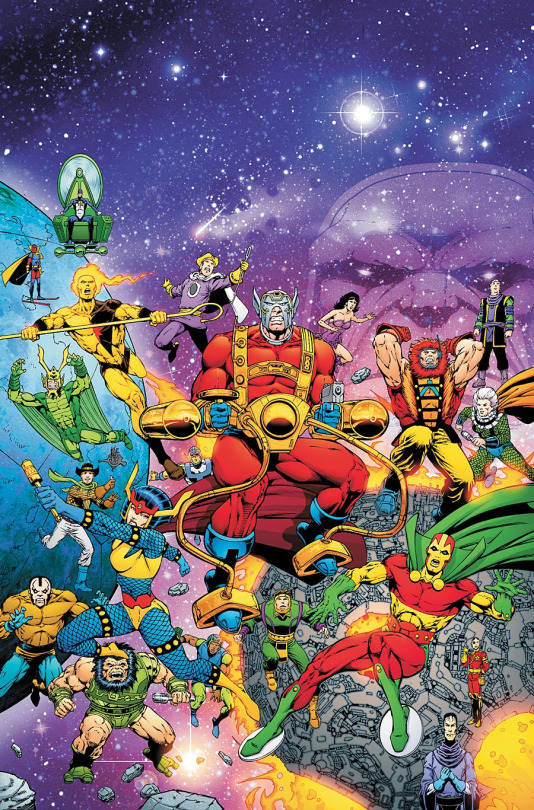
So a New God is a being that is from New Genesis or Apokolips. Respectively you can see them as a heavenly place or a hellish landscape. Batman believes each New God represents something, like Orion is War, Mr. Miracle is Freedom, etc. They live on the Fourth world which is in close proximity to the Source, which is basically a place where most of the powers of the universe come from.
“The Source is the "source" of all that exists and acts as the limitless energy from which all life sprang forth in the Universe. The Source created and was created by the emergence of the Universe approximately 19 billion years ago.[1] Mostly associated with the New Gods, the Source was the supposed origin of the "Godwave" that is believed to have been responsible for creating and empowering the "Gods" with their divine abilities. It also seems to be partially responsible for the ability of certain people to develop super-powers, especially those which defy the laws of physics.
Lying at the edge of the known multiverse is the Source Wall, which protects the Source, and traps all those who attempt to pass beyond it as Promethean Giants.”
So New Gods evolved into almost perfect beings due to their close connection to the source, their technology and other factors. They’re faster, stronger, smarter, etc. than their cousins the humans of earth, even though they look like us.
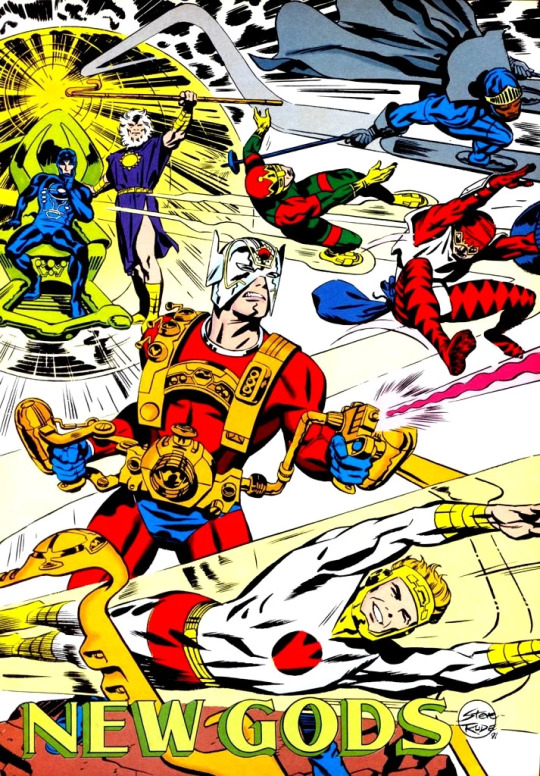
Another factor about the New Gods is that they are technically immortal, have acceletated healing, and you can’t really kill them with natural means, you need a specific sort of material to use against them, or they just will keep healing up and fixing themselves. Now I don’t know if anyone of them has ever revived directly from death, but near death…yes, several times.
They also obtain powers that are pretty much super depending on who it is.
As for the Mother Box…

So these “living computers” are half sentient being half highly developed machine. The New God Himon, who used Tenth Metal to build the boxes, which is seen as possibly being alive, created them and they can do a number of things. Anything from forming a boom tube, to translating, to energy manipulations to teleportation to, even healing an injury.
According to Metron, one of the smartest New Gods, the Mother box shares a rapport with nature and it’s user, providing unconditional love to the person that owns it and will self destruct should the person that owned it die. Keep in mind the mother box can be woven into just about anything, Scott Free has his in his costume as a part of it.
The list of things they can do is wild:
Change gravity
Transfer energy from one place to another
Control the mental state of a host
Communicate with other life forms
Manipulate the life force of a host to sustain it past fatal injuries,
Open and close boom tubes
Take over and control non-sentient machines
Merge sentient beings into a single more powerful being
Sustain a life form in a hostile environment.
Okay so now about Earth 16 Halo….
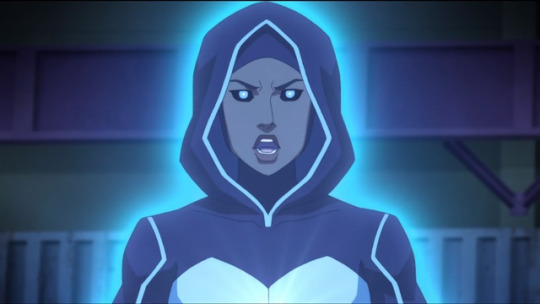
So what do we know about Violet? We know that she was named Gabrielle and that she was a citizen of the republic of Qurac, which has been having strife with Queen Bee. We know that she came to Markovia after being chased down by a group of monsters that seems to be attacking. For some reason she agreed to open the door to let assassins in to kill the King and Queen and then was killed herself to install a mother box in her.
It’s clear by now it’s a mother box. But who did it belong to.
This becomes important I think in understanding the character we have here. Gabriella died, and while the Mother box did revive her, much like the original Halo, this is not the same girl that was Gabrielle. This isn’t a case of amnesia, the only thing keeping Violet alive right now is that box inside her, and that box, should the owner die, will destroy itself, unless it sees Gabriella as it’s owner now.
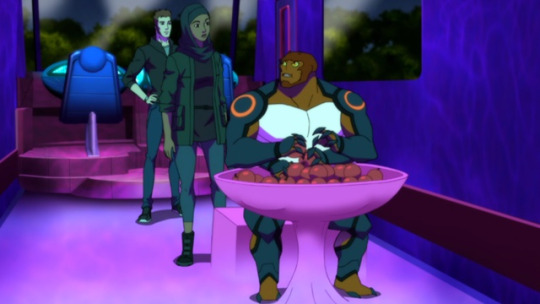
This means that the girl that we have before us isn’t really Gabrielle, she is the Mother box (or New God) taking on a new form, and reading the memories that are storied in Gabrielle’s mind. Because of the fact that the original Gabrielle died, we can then view this person as someone that is, for lack of a better term, wearing Gabrielle’s skin. This also brings up the question of identity and if the being inside her, that being this Mother box, identifies with Gabrielle’s religion or not. Violet at this point clearly feels that continuing to at least wear the hijab is the right thing to do for her, as she says, “it feels right” shows that at least the Mother box is reading the remaining emotions or whatever, inside of Gabrielle’s memories.
A lot of the issues people seem to be having with her centers around if she is her nationality, and honestly I have to say, no, she is not. The moment Gabrielle died and the Mother box activated reviving her, she lost all of that. She became a new person who is learning to be the person that Gabrielle was, but she is not Gabrielle. Thus the taking of the new name. Because of this, you can’t really judge the character on the outfits or actions they put her in based on who Gabrielle was, because this isn’t her anymore, and I don’t think this is ever going to be again. The girl that was Gabrielle died, she is dead, and there is no bringing her back. All we have now is Violet, a person who is learning to be a person, who is experiencing things for the first time inside a person’s body.

Now was it a smart idea to make her a Muslim girl from Qurac, compared to her original form, I don’t know. On the one hand, I can see where the issues regarding her being killed over and over can come off as something horrible. And that her outfit wouldn’t be seen as proper (and compared to M from Marvel this is a pretty fully covered look) compared to say Ms. Marvel’s look. However, on the other side of things, this isn’t Gabrielle anymore and because of that she has to be looked at by a different standard as she has no clue what Gabrielle would and wouldn’t wear. It’s also important to note that their costumes were designed to best suit their powers, and more than likely Fire set Violet up with cloth that would make it easier to use her abilities, much like Geoforce not ripping off all his clothing.
As more and more of Gabrielle’s memories come back, the likelihood is that Violet will have to face a choice to live as Violet or as Gabrielle. There’s also the added issue of the Mother Box and, well, who’s it is and if there is a New God in her or at least, accessing her body.
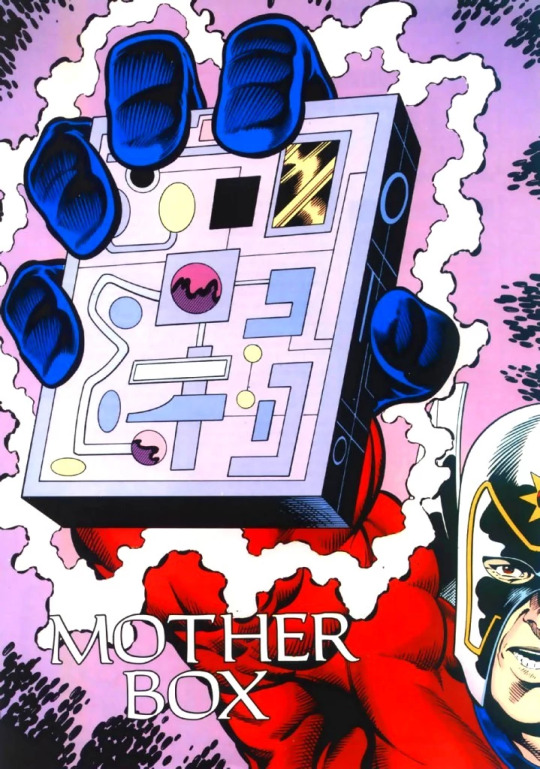
Keep in mind also that Mother boxes don’t normally create illusions, but New Gods do. Right now there’s some form of confirmation that the Mother box is inside Halo, thus making her what she is. We know that the powers she has seems to mirror that of the Mother boxes, and yet there are a few that don’t.
Halo can fly, while the Mother box can alter gravity it can’t make someone fly. Halo can cast illusions, create beams, Force fields, etc. the Mother box can’t do that –unless that falls under energy manipulation, which it could, but it still leads to the other option that could be happening here.
The Mother box is working in tandem with a New God is one of the other options for this. We’ve heard that the Mother box is inside Halo and keeping her alive. However there is the option for a New God to be using the body as well. New Gods can poessess others, it’s one of the options of their powers, and the one New God that matches a lot of the powers that Violet has right now is Solis, or Light Ray.
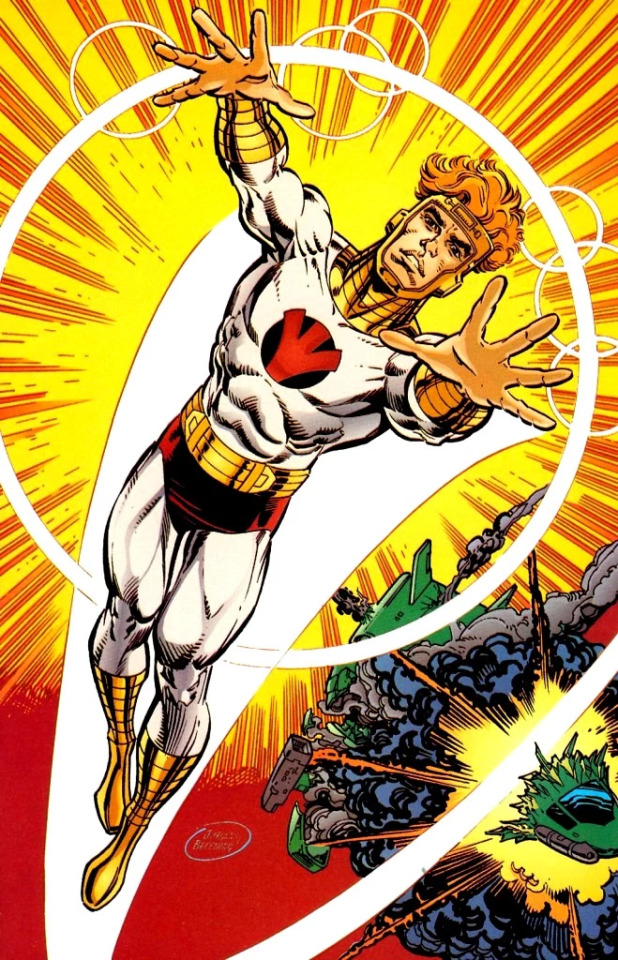
Lightray or Solis, is the best friend of Orion, a powerful New God that can fly, has accelerated healing, Photokinesis or the ability to manipulate light in many ways, including force fields, blasts and casting illusions. The reason I bring him up at all is because of what Bear states in Away Mission. During the episode Bear, says that that the Real Orion is away from New Genesis. Now why could that be?

Originally I thought that this meant that the Mother box could be Orion’s and that they were holding him captive. However, the big thing about this is that you don’t just capture a Mother Box, it’s not easy to get, and the other factor is that Orion’s controls his beast/rage form. Without it he becomes a wild animal.
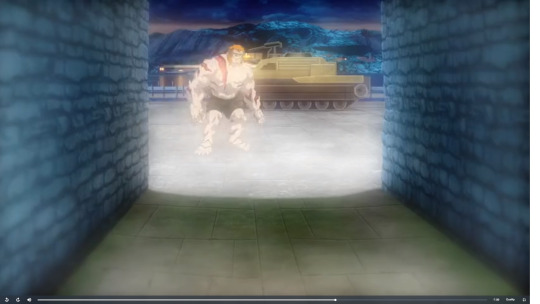
Which could explain the monster we see chasing down Halo and the others in her memories.
The other option is that the mother box belonged to Lightray who is being held prisoner, as with Orion, only he tapped into his connection with his Mother box and is now connected to it allowing Halo to access his powers until help can arrive in the form of Orion.
So we have three options here.
Option 1. Halo’s powers come strictly from the Mother Box and the Mother box has become the person Violet that is now inhabiting the mortal remains of Gabrielle Doe, who was the girl from Qurac that died at the hands of Ecks and the others.
Option 2. Halo’s powers are coming from a mix of the Mother box and Lightray/Solis who is right now incapacitated and is using his mother box inside Halo to keep others from using him for whatever purpose that they will. And that Orion is looking for his best friend, thus why M’comm was able to pretend to be him.
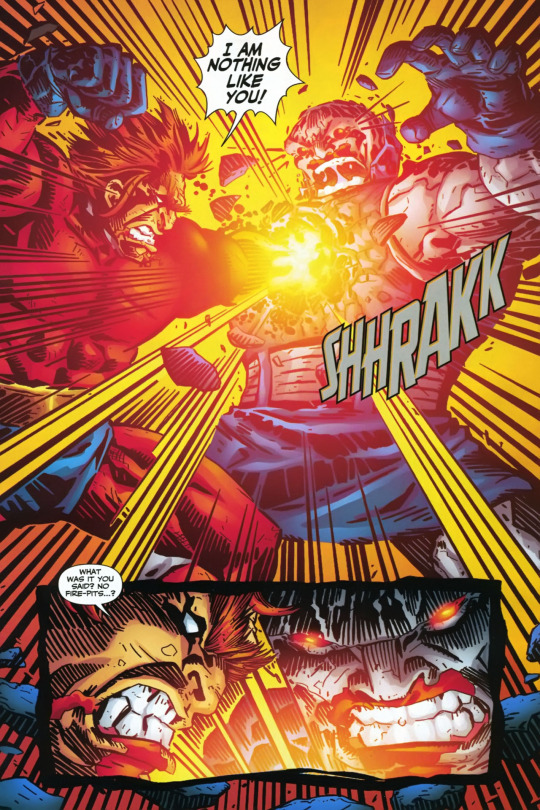
Option 3. Halo’s powers are coming from the Mother box, but the box belongs to a captured Orion. Should Orion be saved this could put a serious issue up in the air for Halo. As the Mother box would belong to Orion this would mean it may have to be removed as it has a connection to Orion and would want to go back with him home, since it helps calm him down. Orion could be a dick about it and want it back as well leading to a fight over Halo and her life, or he could be talked down from it by Bear and the other Forever people, which is also an option here.
Ultimately I feel like a lot of people are viewing Halo in a way that seems to be under the impression that she’s alive. Let me reiterate, she is not. She is not the girl that died, she is a vastly different character, one who’s deaths I think mean something. Each death may be processed by the Mother box for a reason, and probably will be used later in the story. As she understands that pain the box can then probably dish out everything upon someone that is attacking them at some point. That is honestly where I think we are going with this.
I hope this all makes sense.
#young justice: outsiders#young justice spoilers#young justice outsiders spoilers#young justice season 3#young justice theories#young justice theory#young justice#yj spoilers#yjo spoilers#yj:o#yjs3#yj outsiders#yj season 3#yj#yj theory#yj theories#halo#gabrielle daou#violet harper#violet#orion#lightray#solis#new gods#mother box#DC comics
101 notes
·
View notes
Text
Mr. Robot: 10 Of Elliot's Best Quotes, Ranked | ScreenRant
One of the most mind-bending series on TV right now, with one of the most complex and multi-layered characters, Mr. Robot took the small screen by storm when it debuted in 2015. Now gearing up for its fourth and final season, set to premiere on October 6 with 13 episodes, we can expect many more twists and turns to come.
RELATED: 10 Technological Threats In Mr. Robot That Are Actually Real
Setting up a hacktivist group called Fsociety, or rather following the direction of a character known as Mr. Robot (played by Christian Slater) to create and lead this group, he aims to destroy the company and reset the world. Through his efforts, dissociative identity disorder, paranoia, and delusions, Elliot delivers some seriously disturbing but also thought-provoking lines. Here are his 10 best, ranked.
10 Wars Aren’t Meant To Be Won

“Maybe wars aren’t meant to be won, maybe they’re meant to be continuous.”
This sad realization suggests that wars are simply an ongoing product of the world we live in. You fight a war with one person or organization or situation, and then move on to the next. It’s purely cyclical, depressing, and never-ending.
This is the way Elliot always thinks; pessimism is in his blood. And maybe he’s right. Any time we win one war, another emerges. So do we really ever win at all? Or simply replace one war with another and call it something different?
9 Living in Paranoia

“We’re all living in each other’s paranoia.”
Elliott is mentally ill, seeing a therapist to deal with his identity issues, depression, anxiety, and severe paranoia. So to him, everyone is paranoid, really. We all just live based on the paranoia of others.
If one person suspects another of cheating in their relationship, for example, that suspected guilty party must live with their significant other’s paranoia. If you feel as though your boss is out to get you, your boss is going to live with the repercussions of your beliefs, whether it’s you lashing out at them or always questioning their motives. This, at least, is what Elliot believes about the world.
8 Find the Worst in People

“I’m good at reading people. My secret? I look for the worst in them.”
The expression goes that you should always look for the best in people. But to Elliot, if you really want to know someone and what they are all about, look for the worst in them. That will tell you who they really are behind the mask they throw on and the person they portray themselves to be every day.
Does the worst about a person truly define them? Is that who they truly are? In Elliott’s eyes, they are. Others who think more optimistically might simply believe that the worst in someone is just the worst they could be, but who they really are is reflected when they bring out their best.
RELATED: MBTI Of Rami Malek ‘s Famous Roles
7 The Code of Chaos

"I do see the beauty in the rules, the invisible code of chaos hiding behind the menacing face of order."
Leave it to Elliot to turn the concept of conventional rules into chaos. In his mind, rules are simply organized chaos, meant to manipulate and control people into living in a personal sense of chaos. But this truth is masked beyond what the rules present, which is a seemingly organized stream of people simply living out their daily lives, going through their motions.
In this comment, he’s admitting that he recognizes the appeal of the rules, it does make the chaos invisible. But he sees right through them. And he wants others to as well.
6 People are Vulnerable

“I’ve never found it hard to hack most people. If you listen to them, watch them, their vulnerabilities are like a neon sign screwed into their heads.”
Throughout the series, we’ve seen Elliot use his tremendous hacking skills for what he believes to be a greater good, delivering his own sense of vigilante justice. When he believes that someone is up to no good, he hacks into them, finds proof, then essentially blackmails them to coerce them into doing what’s right.
He’s admitted that he often hopes he’s wrong and has hacked into an innocent person. But he believes that he is so perceptive that he can spot those who are doing wrong, and only hacks them to find the proof he already knows is there. This is confirmed in another great quote:
“…I never want to be right about my hacks, but people always find a way to disappoint.”
5 It’s Not Real

“It's one thing to question your mind; it's another to question your eyes and ears. But, then again, isn't it all the same? Our senses just mediocre inputs to our brain? Sure, we rely on them, trust they accurately portray the real world around us, but what if the haunting truth is they can't? That what we perceive isn't the real world at all, but just our mind's best guess? That all we really have is a garbled reality, a truly fuzzy picture we will never make out?”
This is one of those lengthy internal monologues delivered by Elliot that really makes you stop and think. Is what you perceive actually real, or just how you perceive something? Do other people see things the same way you do? Is everyone just making their own best guesses about situations, and often times, our views are all completely different? Could this explain so much of the conflict in the world?
It's a really troubling and thought-provoking statement that might make you question, well, everything.
RELATED: Mr. Robot: 10 Things That Need To Happen Before It Ends
4 Our True Selves

"Annihilation is always the answer. We destroy parts of ourselves every day. We Photoshop our warts away. We edit the parts we hate about ourselves, modify the parts we think people hate. We curate our identity, carve it, distill it. Krista's wrong. Annihilation is all we are."
Especially in today’s world where we are so focused on presenting our ideal selves through social media, endlessly editing photos until we find the best one to post, using unrealistic filters, and trying to present the best versions of ourselves aesthetically, Elliot hits this nail right on the head.
Krista, his therapist, tries to explain to him that annihilation is not what we need, but to Elliot, that’s exactly what we do every day.
3 Control Is An Illusion

"Control can sometimes be an illusion. But sometimes you need illusions to gain control. Fantasy is an easy way to give meaning to the world. To cloak our harsh reality with escapist comfort. After all, isn't that why we surround ourselves with so many screens? So we can avoid seeing? So we can avoid each other? So we can avoid truth?"
For any fan of the series, you know that Elliot himself is prone to illusions, or rather hallucinations. But to him, he thinks the fantasy is, well, his reality. It’s what helps him control a situation, when he’s, in a way, living outside of himself.
We all do it, as Elliot notes, by immersing ourselves in fantasy movies and TV series (like Mr. Robot), scrolling through social media feeds with profiles that only show one side of peoples’ lives, and cutting ourselves off from reality by escaping to a digital world via an entertainment medium like gaming. Is that really all that different?
2 The World Is A Hoax

“The world itself's just one big hoax. Spamming each other with our running commentary of bullshit, masquerading as insight, our social media faking as intimacy. Or is it that we voted for this? Not with our rigged elections, but with our things, our property, our money. I'm not saying anything new. We all know why we do this, not because Hunger Games books make us happy, but because we wanna be sedated. Because it's painful not to pretend, because we're cowards.”
Whoa. Just whoa. Those are the only words we can use to describe this quote from Elliot, which completely calls out every social media tactic, every way we, as a society, have focused on material goods and unimportant fake relationships versus real ones.
He believes all of this numbs us to reality, to what’s really going on in the world. And he might just be right.
1 Saving The World

“I wanted to save the world.”
It’s the shortest of the quotes, but one of the most impactful. While what he accomplished with Fsociety was terrible and had severe implications on society, he really did have good intentions. Behind all of his cynicism was a young man who simply wanted to re-program the world and make people focus on what was important; forgive the debt people had incurred due to greedy banks and investments, and take the money and power away from corporate conglomerates and give it back to the people.
Of course, it backfired. But in the end, Elliot really did just want to save the world and thought his actions would have done just that.
NEXT: 10 Things Mr. Robot Gets Right About Hacking
source https://screenrant.com/mr-robot-elliot-best-quotes/
0 notes
Photo

CHARLES RIVER EDITORS – THE EAST AFRICAN SLAVE TRADE: THE HISTORY AND LEGACY OF THE ARAB SLAVE TRADE AND THE INDIAN OCEAN SLAVE TRADE – 2017
The title bothered me from the very start. But I wanted to see what was inside. If we speak of old slave trade bringing Black African slaves into the vast area covering the Mediterranean Sea and the Middle East, or even the Indian Ocean and the Indian subcontinent, and eventually the rest of Asia, we do have a problem. At the level of the world per se we also have the same problem. Slavery developed with the emergence of agriculture and herd husbandry after the Ice Age, between 12,000 and 5,000 BCE. These new economic and productive activities required a new division of labor that made people available when necessary for the crops – cultivation, harvesting and storing. This new division of labor was harsh and the initiative of individuals was no longer necessary. What used to be more or less collective work became slave work when the property of the land and the organization of work was in the hands of a very narrow minority of “free” people. Slavery as such had nothing to do with Islam. In fact, it is clearly present in the Bible (Abraham is given his wife’s slave by his own wife Sara for him to get a son since she, Sara, cannot perform the service. That’s Ishmael. But God being what he is, he grants a son to Sara afterwards. That’s Isaac. Then Sara, the wife, asks Abraham to throw the slave maid of hers and her son Ishmael out into the desert to die of thirst and hunger. But God being what he is, he saves both the slave mother and the slave son Ishmael. We know what will happen later. Isaac is the founding figure of the Jewish and later Christian religions and Ishmael is the founding figure of Islam. Abraham being common to the three religions.
Plato, Socrates and Aristotle all defended a slave society in which the slaves were the majority of the population. In Sparta, one day a year, the free citizens had the right – and duty – to go hunting the slaves normally working the fields of the city. The free citizens could kill these slaves the way they wanted and as many as they could. The big empires in the Middle East, Sumerian, Akkadian, Persian and all other Hittite or Anatolian empires, had a vast number of slaves. One dynasty of Pharaohs in Egypt is known as the Black Pharaohs and are the black slaves used as soldiers in Egypt who managed to seize power for a century or so. The Roman Empire was basically a slave empire. And the arrival of Christianity with Constantine did not change that. In fact, it was changed only when the Germanic tribes arrived because they did not practice that kind of slavery (and the gates of Rome were opened by slaves for the Germanic invaders to come in during the night) and it is Charlemagne who introduced the religious reform of the 9th century that will bring feudalism that rejected slavery by principle, replacing it with serfdom. Black slaves in all these empires were common and the practice of eunuchs was also common. Eunuchs were generally abducted at an early age, before puberty most of the time. They were castrated level to the abdomen and the survivors were entrusted with the numerous harems of these empires. Roman Emperors, like Julius Caesar and all the others had private counselors who were slaves most of the time.
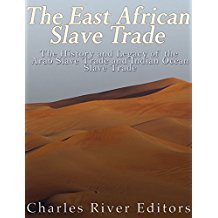
So I was surprised – at least – when I found out that this book de facto starts slavery in this region of the world as being Arab and clearly Muslim. There is one allusion to a very old system but no precision. In fact it sounds as if slavery was started in this region in the 8th or 9th century in Arab countries to be understood as meaning Muslim countries, forgetting that Iran, most of Iraq, Pakistan, Afghanistan, etc. are not Arab but all of them Turkic or Indo-European or Indo-Aryan, not to speak of Turkey itself and vast areas in the Caucasus, around the Caspian Sea and in Central Asia including vast areas of western China that were of course not Arab or Arabic since they spoke Turkic languages.

Yet the book insisted on an element that is essential and without which the slave trade in the Indian Ocean would never have been what it became after the 15th century. The Portuguese controlled the vast section of central and southern Africa from the Atlantic Ocean to the Indian Ocean: Congo, central African small areas that have become Rwanda, Uganda, and some others, Angola, Mozambique, and many islands in the Indian Ocean, plus India of course, meaning the Indian subcontinent. One of their main activity was transatlantic slave trade to the Americas, though they were joined there by the Spanish, the English, the Dutch, the French and a few others. But in the Indian Ocean the Portuguese were alone for at least three centuries. They used some kind of agreement with the “Arab” traders, meaning of course the Muslim traders who collected slaves along the eastern coast of Africa and took them to the Middle East, Egypt included, the Indian subcontinent and the whole Muslim world. Though a map shows another slave trade from western Africa to the Maghreb, Libya and Egypt, the book does not say a word about this one. The land routes from western Africa (the Mali empire that became officially Muslim in the 13th century) and from eastern Africa ‘what is today Sudan, Ethiopia and Somalia were highly frequented across the desert and they were the normal routes for future eunuchs. The boys were operated upon in special stations: survival rate about 50%. No official figures.

The book hints at the old practice going back to before Christ, even prehistory, of some tribes establishing themselves as dominant (that will be easy when a Middle East empire or the Roman Legion, etc. will support them, later the various Muslim countries and their traders and the Portuguese not to speak of the French in many islands and the English who take over after the Portuguese in the second half of the 18th century. These dominant tribes (the Swahili and the Yao, and quite a few more) managed to convert to Islam, which protected them since a Muslim cannot be enslaved by another Muslim, and then they raided the inner tribes, seen as less powerful, especially since they are not provided with modern military means and they have suffered from this exploitation for millennia (four or five or more), are systematically kept away from Islam and they provide, at times peacefully with some kind of an agreement with the raiders, the quota of slaves demanded by the raiders. It’s only hinted at not explained.

The consequences are that when the English, like Livingstone arrives with Christian missionary objectives, they will convert these animist populations to Christianity in order to bring them together and make them resist the millennia old practice. It is this minority Muslim tribe versus majority Christian or animist tribes that is at the very basis of today’s tribalism in Africa. The French and the English when they arrived just kept the dominant tribe in power, tolerated the slave trade against the majority tribes and little by little, slowly and painfully, managed in two centuries to bring this trade to something like a halt. The details on the subject are only trying to save the face of the English as being the main liberators, forgetting to say that colonialism took over. It was no longer slave work but colonial work. Not much difference indeed. Let say some very brutal serfdom.

The book is short on one more element. It alludes to the Code Noir (there is a Spanish version of it) of Louis XIV. It does not at all take into account the various practices of the various Christian countries in the Americas. The French and before them the Spanish with the Inquisition and Royal justice impose some strict limitations to the practice of slavery in their American colonies that imposed their Christianization, their marrying in the Catholic Church and the vast practice of manumission (a slave could buy his freedom because he or she had some personal income authorized by his or her master, and anyone could buy the freedom of any slave at any time. That produced the three tier society of the ex-Spanish or ex-French colonies and territories (including Louisiana). On the other hand, the Protestants of the Netherlands or Great Britain refused to recognize the human dimension of slaves, refused to Christianize them and they imposed a brutal over exploitation and the famous theory of the one-drop-of-black blood that supposedly makes you Black. Livingstone was in other words an exception and the book makes one allusion to the Hindu caste system but does not go as far as saying that the Dalits are nothing but slaves.
I think this book seems not to have read the following title that they should read urgently to widen their minds on the subject. “The Indian Ocean From Admiral Zheng He To Hub And Spoke Container Maritime Commerce” by Dr. Jacques COULARDEAU & Ivan Eve, Kindle Book, ASIN: B01AY2H0JC, January 2016. The first part of the book is on the subject of slavery in the Indian Ocean. Commentary, review and presentation at https://www.academia.edu/29122940/A_LONG_JOURNEY_IN_THE_WORLD_IN_THE_MIND_IN_THE_SOUL_OF_MAN

One shortcoming is of course the position of Muhammad on slavery: he found it when he took over the Arab world at first and he limited it to non-Muslims and edicted many rules to make it acceptable though he did not in any way softened the lot of eunuchs or future eunuchs. The book is totally silent on the point. You find the same limitation in the Mandingo Charta instated by the first Muslim Malian Emperor in the 13th century: “In the early thirteenth century, following a major military victory, the founder of the Mandingo Empire and the assembly of his wise men proclaimed in Kurukan Fuga the new Manden Charter, named after the territory situated above the upper Niger River basin, between present-day Guinea and Mali.” They just forget to say the victor is Muslim and imposes Islam to the ruling class of the empire (https://ich.unesco.org/en/RL/manden-charter-proclaimed-in-kurukan-fuga-00290). Have a good trip and remember that Admiral Zheng He was a Muslim and a castrated slave of the Chinese Emperor.
Dr. Jacques COULARDEAU

0 notes